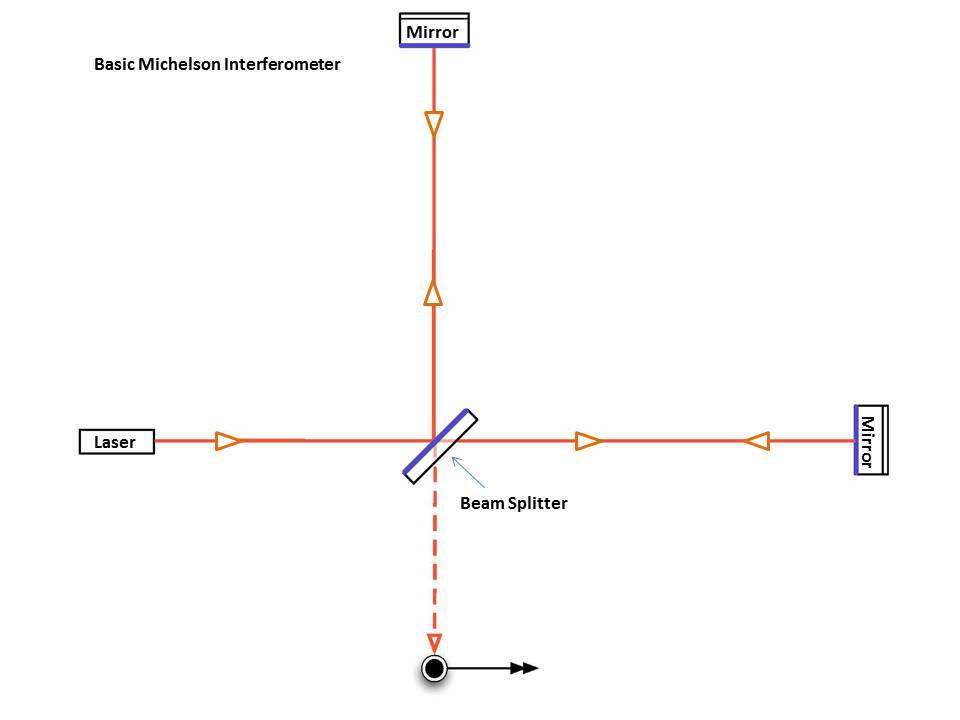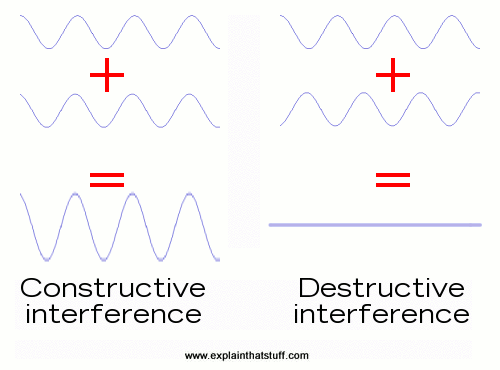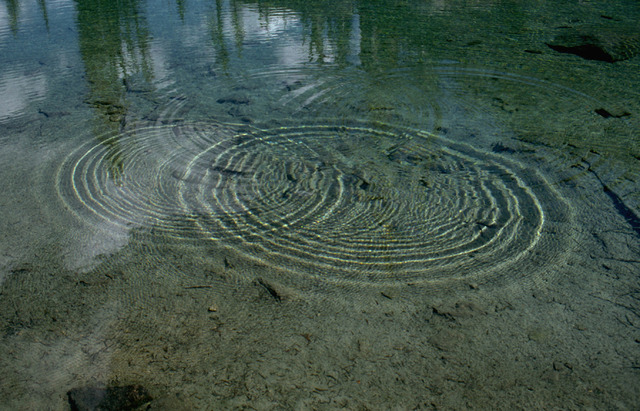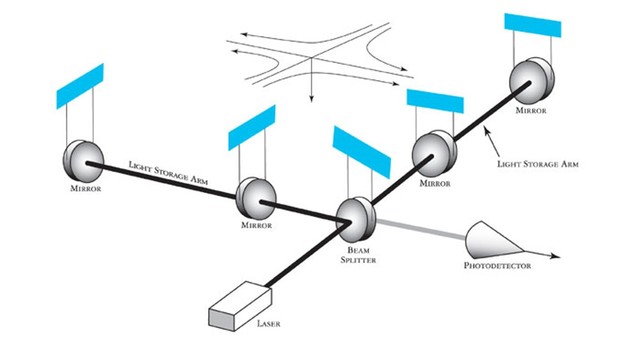
Basic schematic of LIGO's interferometers with an incoming gravitational wave depicted as arriving from directly above the detector. (Credit: Caltech/MIT/LIGO Lab)
What is an Interferometer?
Interferometers are investigative tools used in many fields of science and engineering. Pioneered in the mid- to late-1800s, they are called interferometers because they work by merging sources of light to create an interference pattern, which can be measured and analyzed: hence 'Interfere-meter', or interferometer. The interference patterns generated by interferometers contain information about the object or phenomenon being studied. They are often used to make very small measurements that are not achievable any other way.
Layout of a basic Michelson Interferometer using a laser as the light source. (Click for larger image)
Because of their wide application, interferometers are used to measure everything from the smallest variations on the surface of a microscopic organism, to the structure of enormous expanses of gas and dust in the distant Universe, and now to detect the nearly imperceptable motions caused by gravitational waves (a distance 1/10,000th the width of a proton!) Despite their different designs and the various ways in which they are used, all interferometers have one thing in common: they superimpose beams of light to generate an interference pattern. The configuration of a basic Michelson interferometer (seen at right) consists of a light source, a beam-splitter, two mirrors, and a photodetector (the black dot) that records the interference pattern.
LIGO's interferometer is a much more complex version of a Michelson interferometer, but functionally, it is very similar: A laser beam from a single source is split in half. Each beam travels down an arm perpendicular to the other, bounces off a mirror at the end, and returns (ultimately) to be reunited ("interfered") with its partner. By studying how the beams interfere, we can determine if a gravitational wave has passed.
To learn a bit more about how interferometers work, visit the sections below.
Anyone who has thrown stones into a flat, glassy pond or pool and watched what happened knows about interference. When the stones hit the water, they generate concentric waves that move away from the source. Where two or more of those concentric waves intersect, they interfere with each other. This interference can result in a larger wave, a smaller wave, or no wave at all. The visible pattern occurring where the waves intersect is an interference pattern.
|
The principles of interference are easy to understand: Two or more waves interact. Add the heights and depths of the separate waves where they interact, and the result is the interference pattern. The figure at right shows two specific kinds of interference: total constructive interference and total destructive interference. Total constructive interference happens when the peaks and troughs of identical waves perfectly meet up: you construct a larger wave equal in size to the sum of the heights (and depths) of the merging waves at each point where they intersect. Total destructive interference is the exact opposit. When the peaks of one wave meet and exactly match the troughs of identical waves, they cancel each other out and no wave results. Of course, in nature, two or more waves are rarely identical, and the peaks and troughs of one wave will rarely perfectly meet the peaks or troughs of another wave like the illustration shows. Regardless, no matter how they differ, when the waves intersect, the result is always the sum of the heights and depths of the waves wherever they intersect. The animation below illustrates this effect in an ideal case of two identical waves moving in opposite directions. As the red and blue waves move through each other, the black wave shows how they interfere. Here, the combined (black) wave experiences a full range of heights from twice as high/deep (total constructive interference) to flat (total destructive interference), changing as long as the red and blue waves continue to interact. In the real world, the interacting waves would be of different amplitudes (heights) and frequencies (widths) so as they interact, the resulting wave would be more complex, but the principle of adding the heights/depths of the interacting waves at each point still applies. |
The changing black wave is the interference pattern created by the red and blue waves as they pass through/interact with each other. (Credit: Wikimedia Commons)
It just so happens that light waves behave just like water waves. When two beams of laser-light merge, they too generate an interference pattern that depends on how well-aligned the light waves are when they combine. Just like water, when the peaks of the waves of one beam perfectly meet the troughs of another, total destructive interference occurs. In water, the result is no wave; in light, the result is no light! Conversely, when the peaks of one beam perfectly meet the peaks of another, total constructive interference occurs. Again, in water, the resulting wave is a sum of the heights of the interacting waves; in light, the result is a brigher light--the sum of the brightnesses of the two separate light beams. As the waves move past or through each other, they can experience a full range of interference from partial interference to total constructive and destructive interference. In water, that means a bigger wave, a smaller wave, or no wave. In light, the result is a full range of brightness, from darkness to the sum of brightnesses of the interacting beams. This means that the alignment of the waves as they interact dictates the resulting interference pattern.
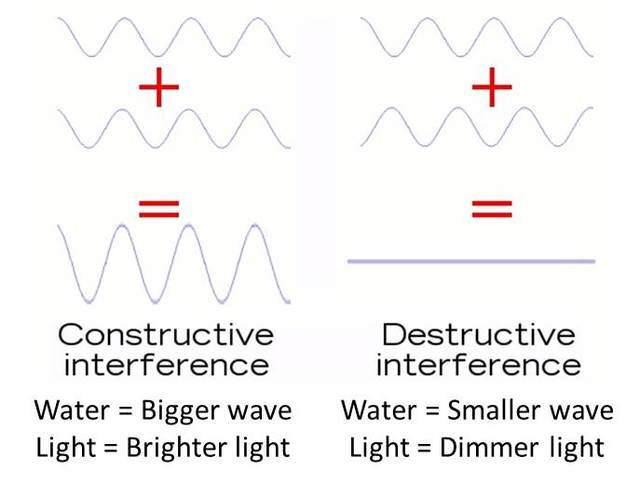
Parallels between constructive and destructive interference in water and with light. (Adapted from www.explainthatstuff.com)
How do Gravitational Waves Affect LIGO's Interferometer?
In LIGO's interferometers, what dictates how well-aligned the laser beams are when they recombine is simply the distance each one travels in its arm. As long as the two beams travel the same distances, then when they recombine, they totally destructively interfere and no light comes out of the instrument (LIGO was deliberately designed this way). But if they travel different distances, then when the beams recombine, their light waves are no longer perfectly aligned, and some light leaks out!
This is what happens when a gravitational wave passes. Gravitational waves cause spacetime itself to oscillate, alternately stretching in one direction while compressing in a perpendicular direction. This oscillations last as long as the wave is passing. In the presence of a gravitational wave, then, LIGO's arms also oscillate in length, thus causing the lasers within them to travel different distances before recombining. The technical term for this oscillation is "Differential Arm" motion, since the arms simultaneously change lengths in opposing ways. Now, as the beams recombine, they are out of sync, or "out of phase", and no longer totally destructively interfere. Instead, the merging beams shift in and out of phase, and a flicker of light emerges from the interferometer, as illustrated in the animation below [Credit: Einstein's Messengers U.S. National Science Foundation (NSF)].
While in principle, using interferometers to detect gravitational waves is elegant and seems almost simple, in practice, it one of the most difficult things human beings have ever achieved. The change in arm length caused by a gravitational wave can be as small as 1/10,000th the width of a proton! Plenty of things on Earth cause vibrations billions of times larger, so the only way we can sense such impossibly small motions is through some impressive and unprecedented engineering. To learn about how we can filter out enough terrestrial vibrations to enable us to sense gravitational wave vibrations, visit LIGO Technology.

